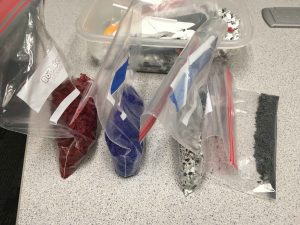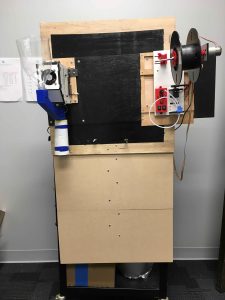By Emily Logan
The plastic recycling machine project is well underway at the Digital Scholarship Center!
I have vertically mounted the Filastruder and Filawinder to a mobile-friendly cart for easy transport. The Filastruder is a simple DIY mechanical design made from parts that can be found at home. The machine uses a temperature controller, thermocouple, a motor from a drill that is attached to a drill bit that spins the plastic down the metal tube where it is heated up using a heater band. Small computer fans are used to cool the motor down and cool the plastic as it comes out of the nozzle. It is mounted vertically to allow for the gravity to naturally pull the plastic downward at a uniform diameter of 1.75mm. A uniform diameter is important when using the filament for 3D printers; if the filament is not a consistent diameter it may jam the printer. The Filawinder is a remote controlled filament winding machine that is powered by an Arduino that can control the speed and direction in which the filament is wound. It even comes with a little laser that can track the flow rate of how fast the Filastruder is printing new filament. The laser communicates with the Arduino and will allow the motor to spin at the same speed that the Filastruder is printing filament. Since the machine automatically winds the filament onto a spool, it can easily be connected to a 3D printer once the filament is created.
Acrylic shelves were laser cut and are being assembled to act as storage for various types of plastic.
I have successfully ground up several different types of plastic from a few failed 3D prints, and have made several spools of recycled filament. Currently, I am using a blender to grind the failed 3D prints (PLA Plastic), but eventually we will have a plastic shredder built by students in the engineering department. These two students will be working with the Digital Scholarship Center for their Senior Engineering Design Project to help make recycling plastic more accessible in house.



With grant money from the Digital Scholars Program, I was able to purchase a Monoprice MP Mini Delta 3D Printer to test my recycled filament on. The printer is only $159, it is very light weight/portable (30.6 lbs.). Delta printers consist of three arms on rails that move up and down independently to move the print head. These printers use trigonometric functions based on angles that the arms create to determine the precise location of the print head within the 3D print space. One of the benefits of delta printers is that they were made for speed, but sometimes this comes at a cost for quality of precision. The printer works great for rapid prototyping and for quickly testing prints that will help see the viability of my recycled filament.
The plastic recycling machine has successfully created DIY filament and recycled filament. In the photo below, the brown cube was printed using the Monoprice printer with filament made in house at the DSC from virgin plastic. The grey cube was my first attempt at printing an object with recycled 3D print filament made in house. Though the print looks a little dilapidated and brittle, this is the first step to making recycled filament a viable option in the makerspace. Making filament is a lot like cooking and often depends on the recipe of plastic compounds that are mixed together. It takes a lot of experimentation to see what materials work well together. Filastruder has a large open source following, and many people all over the world are experimenting with different types of filaments. Here is a link to the forum that I have been following that includes experiments with similar DIY filament projects.
The DSC and other makerspaces on campus have the potential to recycle more of the materials in their space to help contribute and align with the city’s aggressive zero waste goals. These machines can also be utilized as educational tools to students, faculty and staff on the recycling process and contribute to behavioral change related to waste on campus.
To stay up to date with what is happening in all things plastic recycling at the DSC follow @space_on_space on Instagram.






Do you mind if I quote a couple of your articles as long as I provide credit and sources back to your site?
My blog site is in the very same niche as
yours and my visitors would certainly benefit from some of the information you provide here.
Please let me know if this okay with you. Many thanks!
absolutely.